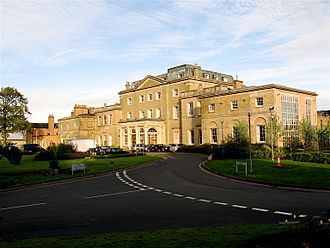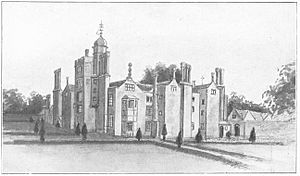Hindlip Hall facts for kids
Quick facts for kids Hindlip Hall |
|
|---|---|

The hall in 2005
|
|
| General information | |
| Type | Stately home |
| Location | Hindlip |
| Coordinates | 52°13′19″N 2°10′12″W / 52.222065°N 2.170056°W |
| Completed | 1575 (rebuilt. c. 1820) |
| Owner | in the care of the West Mercia Police |
Hindlip Hall is a large, impressive house in Hindlip, Worcestershire, England. The first main building was finished before 1575. This historic house played a big part in two famous events: the Babington plot and the Gunpowder plot. It was known for having secret hiding places called priest holes. These were used to hide people who were in danger.
One person, Humphrey Littleton, told the authorities that Edward Oldcorne was hiding there. Oldcorne had been heard leading a special church service at Hindlip Hall. Four people connected to the house faced serious consequences. The owner at the time almost did too, but he was saved by Lord Monteagle.
Later, a poet owned the hall. For a while, it was even a girls' school. The building was rebuilt around 1820. During World War II, in 1940, it was considered a safe place for the government's leaders. Today, Hindlip Hall is the main office for the West Mercia Police and the Hereford and Worcester Fire and Rescue Service.
Contents
The Hall's Early Days
The original Hindlip Hall was built before 1575. It replaced an older wooden house. This new building was made of brick, with tall towers and large windows. It was built by John Habington, who worked for Queen Elizabeth I. John, his wife Catherine, and their three children were all Catholics. At that time, Catholics faced difficulties in England.
After John Habington passed away in 1582, his sons, Sir Edward and Sir Thomas, became involved in the Babington plot. This plan aimed to put a Catholic queen on the throne. Edward was punished severely. However, Thomas was shown mercy because he was Queen Elizabeth I's godson.
Queen Elizabeth herself visited Hindlip Hall. She had dinner there on August 16, 1575.
Secret Hiding Places: Priest Holes
After being held prisoner, Thomas Habington and his wife, Mary, moved back to Hindlip Hall. They had made changes to the house, adding secret priest holes. These were special hiding spots for Catholic priests. Some of these clever hiding places were built by Nicholas Owen. Mary was also related to Lord Monteagle.
When the Gunpowder plot was uncovered, a priest named Edward Oldcorne was at Hindlip Hall. He was a member of the Jesuit order. Oldcorne later explained that on November 8, 1605, Oswald Tesimond arrived from Robert Wintour's home. Tesimond told them that "he brought them the worst news they had ever heard, and they were all undone." He explained that a plan to blow up the Parliament building had been discovered.
In December, Nicholas Owen, Henry Garnet, and Ralph Ashley joined Oldcorne at the hall. They were hiding because they were also suspected of being involved in the plot. On January 20, 1606, the hall was searched. No one was found at first, and Thomas Habington denied anyone was hiding. The four men remained hidden. Garnet and Oldcorne were in one secret spot, while the other two were in another.
The search continued for twelve more days. A document from that time describes how they found "two cunning and very artificial conveyances in the main brick-wall." These were so cleverly built that it took a lot of effort to find them. Three other secret places were found in and around the chimneys. These chimney hiding spots were so well disguised that a careful search might have missed them.
In total, eleven hiding places were found at Hindlip Hall. Two of the Jesuits came out after a few days. Oldcorne and Garnet stayed hidden for eight days before they finally gave up.
Oldcorne and Garnet were arrested by Sir Henry Bromley. They were held briefly at Holt Castle before being taken to the Tower of London. They later faced severe punishment in Worcester.
Thomas Habington was arrested again and sentenced. However, he was spared from the harshest punishment. He spent the rest of his life writing. It is often said he was not allowed to leave the county, but some evidence suggests this might not be true.
After the Gunpowder Plot
Thomas's son, William Habington, became a poet. His son, also named Thomas, passed away without a direct heir. He left Hindlip Hall to Sir William Compton.
Later Years of Hindlip Hall
The original hall was damaged by fire and taken down in 1820.
A new hall was built by Lord Southwell in a Greek Revival style. This means it looked like ancient Greek buildings. After Lord Southwell passed away in 1860, the hall was bought by Henry Allsopp. He was a brewer from Burton-on-Trent and later became the first Baron Hindlip in 1886. The house and its gardens continued to be improved. In 1887, Lord Hindlip created a new lake, covering about 6 acres (24,000 m²). The old lake was filled in, and 4,000 fish were moved.
The Allsopp family moved away in the early 1900s. Hindlip Hall then had several different uses. For about twenty-five years, it was a girls' school.
Hindlip Hall in 1940
During the Second World War, the Ministry of Works took over the hall. There were emergency plans to move important government ministers to Hindlip Hall if needed. The Prime Minister's office would also have been nearby. After the war, in 1947, Worcestershire County Council took ownership. The land was set aside for a future college, and the main house became the headquarters for the County Police.
Hindlip Hall Today
Since 1967, Hindlip Hall has been the main police headquarters for West Mercia Police. It is located near junction six of the M5 motorway. The church of St. James, which is on the property, is no longer supported by the Church of England (since 1997). Instead, it now serves as the church for the police force. In 2018, the Hereford and Worcester Fire and Rescue Service also moved its main office to Hindlip Park, sharing the location with the West Mercia Police.
In 1985, Hindlip Hall was given a special status as a Grade II* listed building. This means it is a very important historic building. While the building itself is not open to the public, you can access the grounds using public footpaths. These paths lead from Hindlip Lane to the south and Pershore Lane to the northeast.


